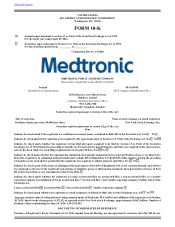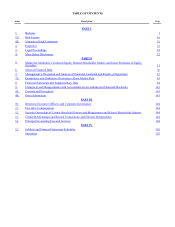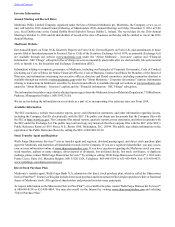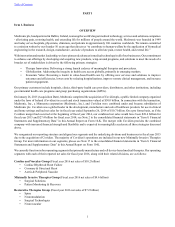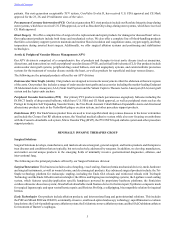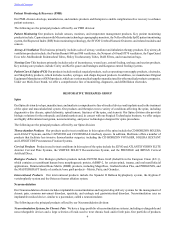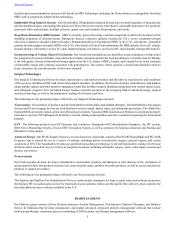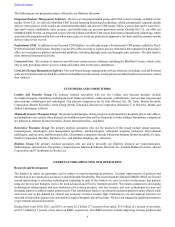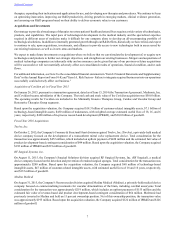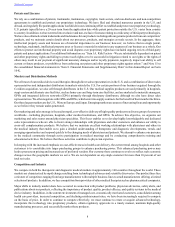Medtronic 2016 Annual Report Download - page 11
Download and view the complete annual report
Please find page 11 of the 2016 Medtronic annual report below. You can navigate through the pages in the report by either clicking on the pages listed below, or by using the keyword search tool below to find specific information within the annual report.
Table of Contents
8
Patents and Licenses
We rely on a combination of patents, trademarks, tradenames, copyrights, trade secrets, and non-disclosure and non-competition
agreements to establish and protect our proprietary technology. We have filed and obtained numerous patents in the U.S. and
abroad, and regularly file patent applications worldwide in our continuing effort to establish and protect our proprietary technology.
U.S. patents typically have a 20-year term from the application date while patent protection outside the U.S. varies from country
to country. In addition, we have entered into exclusive and non-exclusive licenses relating to a wide array of third-party technologies.
We have also obtained certain trademarks and tradenames for our products to distinguish our genuine products from our competitors’
products, and we maintain certain details about our processes, products, and strategies as trade secrets. In the aggregate, these
intellectual property assets and licenses are of material importance to our business; however, we believe that no single patent,
technology, trademark, intellectual property asset or license is material in relation to any segment of our business as a whole. Our
efforts to protect our intellectual property and avoid disputes over proprietary rights have included ongoing review of third-party
patents and patent applications. For additional information see “Item 1A. Risk Factors - We are substantially dependent on patent
and other proprietary rights and failing to protect such rights or to be successful in litigation related to our rights or the rights of
others may result in our payment of significant monetary damages and/or royalty payments, negatively impact our ability to sell
current or future products, or prohibit us from enforcing our patent and other proprietary rights against others.” and Note 15 to
the consolidated financial statements in “Item 8. Financial Statements and Supplementary Data” in this Annual Report on Form
10-K.
Markets and Distribution Methods
We sell most of our medical devices and therapies through direct sales representatives in the U.S. and a combination of direct sales
representatives and independent distributors in markets outside the U.S. For certain portions of our business acquired through the
Covidien acquisition, we also sell through distributors in the U.S. Our medical supplies products are used primarily in hospitals,
surgi-centers and alternate care facilities, such as home care and long-term care facilities, and are marketed to materials managers,
GPOs and integrated delivery networks (IDNs) primarily through third-party distributors, although we also have direct sales
representatives. We often negotiate with GPOs and IDNs, which enter into supply contracts for the benefit of their member facilities.
Our three largest markets are the U.S., Western Europe, and Japan. Emerging markets are an area of increasing focus and opportunity
as we believe they remain under-penetrated.
Our marketing and sales strategy is focused on rapid, cost-effective delivery of high-quality products to a diverse group of customers
worldwide - including physicians, hospitals, other medical institutions, and GPOs. To achieve this objective, we organize our
marketing and sales teams around physician specialties. This focus enables us to develop highly knowledgeable and dedicated
sales representatives who are able to foster strong relationships with physicians and other customers and enhance our ability to
cross-sell complementary products. We believe that we maintain excellent working relationships with physicians and others in
the medical industry that enable us to gain a detailed understanding of therapeutic and diagnostic developments, trends, and
emerging opportunities and respond quickly to the changing needs of physicians and patients. We attempt to enhance our presence
in the medical community through active participation in medical meetings and by conducting comprehensive training and
educational activities. We believe that these activities contribute to physician expertise.
In keeping with the increased emphasis on cost-effectiveness in health care delivery, the current trend among hospitals and other
customers is to consolidate into larger purchasing groups to enhance purchasing power. This enhanced purchasing power may
lead to pressure on pricing and increased use of preferred vendors. Our customer base continues to evolve to reflect such economic
changes across the geographic markets we serve. We are not dependent on any single customer for more than 10 percent of our
total net sales.
Competition and Industry
We compete in both the therapeutic and diagnostic medical markets in approximately 160 countries throughout the world. These
markets are characterized by rapid change resulting from technological advances and scientific discoveries. Our product lines face
a mixture of competitors ranging from large manufacturers with multiple business lines to small manufacturers offering a limited
selection of products. In addition, we face competition from providers of other medical therapies such as pharmaceutical companies.
Major shifts in industry market share have occurred in connection with product problems, physician advisories, safety alerts, and
publications about our products, reflecting the importance of product quality, product efficacy, and quality systems in the medical
device industry. In addition, in the current environment of managed care, economically motivated customers, consolidation among
health care providers, increased competition, and declining reimbursement rates, we have been increasingly required to compete
on the basis of price. In order to continue to compete effectively, we must continue to create or acquire advanced technology,
incorporate this technology into proprietary products, obtain regulatory approvals in a timely manner, maintain high-quality
manufacturing processes, and successfully market these products.

